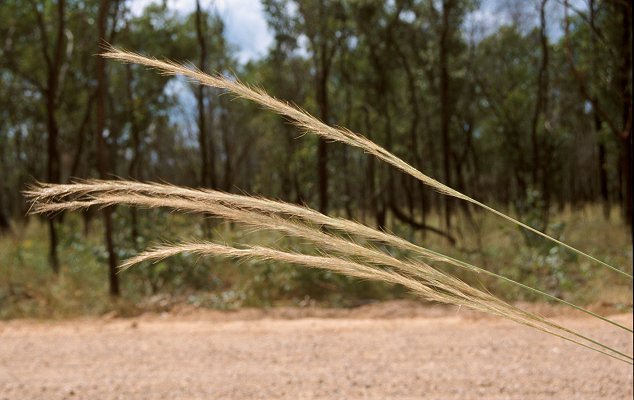Aristida ingrata Domin. Biblioth.
Bot. 85: 346 (1915).
Classification. (GPWG 2001) : Subfamily
Aristidoideae. Aristideae.
Type of Basionym or
Protologue Information: HT: K. Domin s.n., Mar 1910, Australia:
Queensland: Mitchell Dist.: bei Barcaldine (PR; IT: BRI, L).
Key references
(books and floras): [2002] D.Sharp & B.K.Simon, AusGrass, Grasses of
Australia.
Derivation: L.
disagreeable. The sharp callus enables the spikelets to catch on to clothing.
Habit.
Perennial. Culms 41–155 cm tall. Mid-culm internodes glabrous. Mid-culm nodes
glabrous. Lateral branches branched. Leaf-sheaths glabrous on surface. Ligule a
fringe of hairs, 0.5–1 mm long. Leaf-blades curled, 10–23 cm long, 3–4 mm wide.
Leaf-blade surface scabrous.
Inflorescence.
Inflorescence compound, a panicle. Panicle linear or lanceolate, 11–42 cm long,
1.5–4 cm wide.
Spikelets.
Spikelets pedicelled. Fertile spikelets 1-flowered, comprising 1 fertile
floret(s), without rachilla extension, lanceolate, terete, 6–14 mm long.
Glumes.
Glumes similar, thinner than fertile lemma. Lower glume lanceolate, membranous,
keeled, 1-keeled, 1(–3) -nerved. Lower glume surface glabrous. Upper glume
lanceolate, 6–12 mm long, membranous, keeled, 1-keeled, 1 -nerved. Upper glume
surface glabrous. Upper glume apex entire or erose, muticous or mucronate.
Florets.
Fertile lemma 4–8 mm long, without keel, 3 -nerved. Lemma apex awned, 3 -awned.
Median (principal) awn pseudo-articulate at base, without a column. Lateral
lemma awns present. Palea without keels. Anthers 3.
Continental
Distribution: Australasia.
Australian
Distribution: Western Australia, Northern Territory, Queensland.
Western Australia:
Gardner. Northern Territory: Darwin & Gulf, Barkly Tableland. Queensland:
Burke, Cook, Gregory North, Leichhardt, Mitchell, North Kennedy, South Kennedy,
Warrego.
Notes.
A. ingrata differs from A. sciuroides by having smaller
spikelets, a lemma pseudoarticulation and by the leaf blades curling up at
maturity and from A. inaequiglumis by the glumes differing in length by
less than 3 mm.
Occurs from northern
Australia to more arid regions, less frequent in the latter. Acacia, Eucalyptus,
Eremophila, gidgee (Acacia cambagei), mulga (Acacia aneura)
and Melaleuca communities on redearths, loams, sands and alluvial soils.
Flowering and fruiting all year but mainly March to August.




